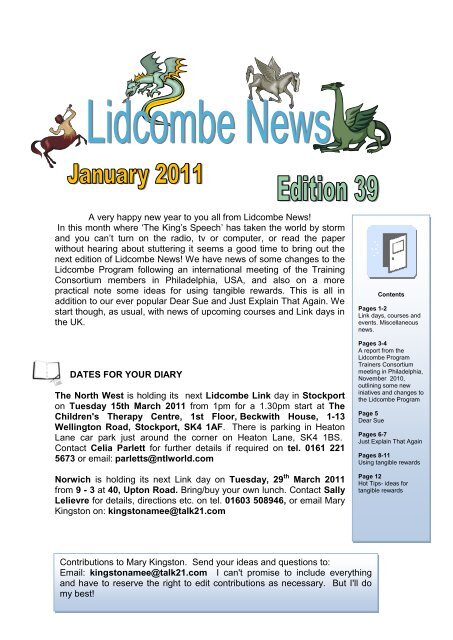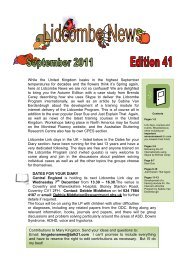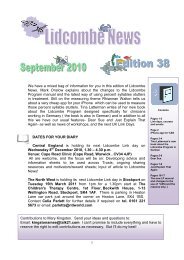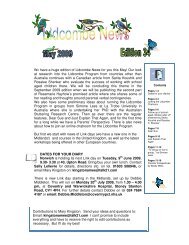Lidcombe News Edition 39th - Montreal Fluency
Lidcombe News Edition 39th - Montreal Fluency
Lidcombe News Edition 39th - Montreal Fluency
- No tags were found...
You also want an ePaper? Increase the reach of your titles
YUMPU automatically turns print PDFs into web optimized ePapers that Google loves.
A very happy new year to you all from <strong>Lidcombe</strong> <strong>News</strong>!In this month where „The King‟s Speech‟ has taken the world by stormand you can‟t turn on the radio, tv or computer, or read the paperwithout hearing about stuttering it seems a good time to bring out thenext edition of <strong>Lidcombe</strong> <strong>News</strong>! We have news of some changes to the<strong>Lidcombe</strong> Program following an international meeting of the TrainingConsortium members in Philadelphia, USA, and also on a morepractical note some ideas for using tangible rewards. This is all inaddition to our ever popular Dear Sue and Just Explain That Again. Westart though, as usual, with news of upcoming courses and Link days inthe UK.DATES FOR YOUR DIARYThe North West is holding its next <strong>Lidcombe</strong> Link day in Stockporton Tuesday 15th March 2011 from 1pm for a 1.30pm start at TheChildren's Therapy Centre, 1st Floor, Beckwith House, 1-13Wellington Road, Stockport, SK4 1AF. There is parking in HeatonLane car park just around the corner on Heaton Lane, SK4 1BS.Contact Celia Parlett for further details if required on tel. 0161 2215673 or email: parletts@ntlworld.comNorwich is holding its next Link day on Tuesday, 29 th March 2011from 9 - 3 at 40, Upton Road. Bring/buy your own lunch. Contact SallyLelievre for details, directions etc. on tel. 01603 508946, or email MaryKingston on: kingstonamee@talk21.comContentsPages 1-2Link days, courses andevents. Miscellaneousnews.Pages 3-4A report from the<strong>Lidcombe</strong> ProgramTrainers Consortiummeeting in Philadelphia,November 2010,outlining some newiniatives and changes tothe <strong>Lidcombe</strong> ProgramPage 5Dear SuePages 6-7Just Explain That AgainPages 8-11Using tangible rewardsPage 12Hot Tips- ideas fortangible rewardsContributions to Mary Kingston. Send your ideas and questions to:Email: kingstonamee@talk21.com I can't promise to include everythingand have to reserve the right to edit contributions as necessary. But I'll domy best!1
Central England is holding its next <strong>Lidcombe</strong> Link day on Wednesday 6 th July,2011 from 1.30 – 4.30 p.m.Venue: Cape Road Clinic (Cape Road, Warwick , CV34 4JP)All LP therapists are welcome, and the focus will be on, amongst other things,discussion and practice of %SS, troubleshooting and sharing of resources. ContactDebbie Middleton on tel 024 7684 4187 or email:Debbie.Middleton@coventrypct.nhs.uk for further details if required.COURSES AND EVENTSIt has been agreed by the <strong>Lidcombe</strong> Program Trainers Consortium that the twoday workshop (three days in countries where English is not the first language)is only for Speech and Language Therapists (Speech Pathologists etc) andstudents in their final semester. It is not designed for parents (unless thay arequalified SLTs), TIs or members of other professions e.g. psychologists, doctors, teachers.NHS Wakefield District’s Speech and Language Therapy Department ishosting a two-day <strong>Lidcombe</strong> training event for Speech and Language Therapists.This will be held on Thursday 24 and Friday 25 February 2011 at WakefieldWildcats, Doncaster Road, Wakefield. The workshop will be led by MaryKingston and Sally Lelievre.For general enquiries about the course, in particular whether there are stillplaces available as the date is very close, please contact Mary Keeley on01977 465417, email: mary.keeley@wdpct.nhs.ukTo book a place, please contact Sarah Yeadon Tel: 01977 665751, email:sarah.yeadon@wdpct.nhs.ukA London based course is being held on Monday and Tuesday October 17th& 18 th 2011 at the Royal College of Speech and Language Therapists.Contact Sally Wynne on email: lidcombe@live.co.uk or Mary Kingston onemail: kingstonamee@talk21.com for the flyer and booking form.The two above courses are the only ones being advertised at present. We dohowever have other courses in the pipeline which may come to fruition.These are department based courses which usually have a few places to sell. If youwould like information about any of these contact Mary Kingston onkingstonamee@talk21.com and I will let you know the current position. Please waituntil late February/early March before contacting me however as it is unlikelyanything will have been firmed up before then.MISCELLANEOUSThis year both Rosemarie Hayhow and Rosalee Shenker wrote papers on the<strong>Lidcombe</strong> Program for the International Stuttering Awareness Day on-lineconference „People who stutter, Inspire‟. These papers and the comments thatpeople made and the authors‟ replies are now archived and can be seen onhttp://www.mnsu.edu/comdis/kuster/stutter.html You may find other articles ofinterest while you are there!2
In November 2010 the Australian Stuttering Research Centre hosted a meeting inPhiladelphia, USA, for the <strong>Lidcombe</strong> Program Trainers Consortium and selectedguests from the ASRC. Not all members were able to attend but below you can seethose of us who made it there.The following article outlines some proposed new initiatives and changes to the<strong>Lidcombe</strong> Program and the training as a result of this colloquium.Back Row L-R :Stacey Sheedy,Ann Packman (ASRC guest),Barry Guitar,Tina Lattermann,LisHarrison, Simone Lees,Brenda Carey,Sue O‟Brian ( ASRC guest),Wendy Lloyd,Rosemarie Hayhow,Rosalee ShenkerFront Row L-R :Jane Kelly (ASRC),Verity MacMillan, Mark Onslow, Melissa Bruce, Mary Kingston,Martin NevdahlA) New initiatives1.Setting up a website dedicated to the <strong>Lidcombe</strong> Program.This is a huge project and will take a while but we hope that eventually that it willcontain some of the following areas and more:Forthcoming training eventsAn area dedicated to parents outlining, for example, what the treatmentshould includeA section on "Why do the <strong>Lidcombe</strong> Program?" for students, cliniciansand parentsCopies of <strong>Lidcombe</strong> <strong>News</strong>Preparation materials for clinicians prior to attendance at theworkshopsThere will also be an area dedicated to and accessible only by clinicians who haveattended the official Consortium workshops.2. Extending <strong>Lidcombe</strong> training to students.Workshop participation to be opened to speech pathology/speech and languagetherapy students who are in the final semester of their professional degree.3. Changes to be made to the manual.A much more comprehensive treatment manual has been proposed.3
B) Changes1. To the <strong>Lidcombe</strong> ProgramTaking the % Syllables Stuttered measure is no longer mandatory whenmoving to Stage 2.In the last edition of the <strong>Lidcombe</strong> <strong>News</strong>, Mark Onslow outlined changes to the useof %SS. He discussed how and why it was no longer necessary to take the %SS onevery clinic visit. (see edition 38 pages 10-17). At the meeting in Philadelphia we allagreed to take this one step further and decided that the %SS could now beremoved altogether from the <strong>Lidcombe</strong> Program. Clinicians however should maketheir own choice as to whether they wish to use it or not while carrying out theprogramme. There are no changes to the use of Severity Ratings.Preparation for Stage 2 is now as follows:Parent home Severity Ratings of 1s and 2s for three consecutive weeks.There should be at least four 1s in each weekAs in all previous visits focus in on a period of time (around 10 minutes ofconversation in e.g. freeplay) with the child before the treatment session withthe contingencies begins. Check back on the Severity Rating accuracy withthe parent. This Within Clinic Severity Rating must also be a 1or 2 for threeconsecutive weeksAsk parents to gather extra information e.g. from family, nursery and preschoolstaffClinicians may also gather extra information e.g. listening to the child inwaiting room2. To the Consortium Training workshopsWe have listened to the feedback that you regularly give us after the workshops andhave agreed to make the following changes :We will be removing the section dedicated to research. Instead it will now bespread throughout the workshop linked to the practical implications. Some ofthe research may also be included on the new website in the pre-workshopsection. We are also hoping to create a video of a recorded conversation withthe theoretical researchers discussing their research which will be availableon the new websiteThere will be changes to the troubleshooting section which will become morepractical and a checklist of questions to help guide thinking in this area will bedevelopedConsortium Members will be compiling a new set of videos - we hope to haveexamples of clinicians working with children from different countries aroundthe worldChanges to the workbooks. The workbooks will have a new format with threeslides per page and a notes section.4
Dear SueI have been working with the <strong>Lidcombe</strong> Program for some three years now and havehad very good outcomes. However I recently received a call from a parent about herchild, Amy, who I saw a while ago and who went through all of Stage 1 and 2 without anysignificant difficulties. Amy is now 6 years 10 months and stuttering again. Her mother says sheis averaging a 4-5 on her SRs and asking why her bumpy talking has come back again. She is notdistressed but says she needs to see her „smooth talking‟ lady again!If this has happened to you how have you managed it? I appreciate individual cases may differbut what procedure do you usually follow? Would you start the <strong>Lidcombe</strong> Program all over againand is this usually successful?Throughout treatment with the <strong>Lidcombe</strong> Program parents are taught to monitor the severity ofthe child‟s stuttering and to allow that to dictate how treatment is implemented. Parents areempowered to proactively manage the child‟s stuttering without direct advice of the clinician,particularly throughout Stage 2. Some children do relapse and start to stutter again aftercompleting the <strong>Lidcombe</strong> Program (Jones, M, Onslow, M, Packman, A, O'Brian, S, Hearne, A,Williams, S, Ormond, T & Schwarz, I, 2008). Parents are routinely told about the possibility ofrelapse and what they should do if it occurs both during and on completion of treatment.Anecdotally I do not see many of these children re-presenting to the clinic after completion ofStage 2. Possibly that is due to parents taking on the role of clinician and re-implementingtreatment once relapse is detected and therefore not requiring further clinical contact.Discussions about relapse emphasises the importance of the parent reacting to the stutteringby immediately re-implementing verbal contingencies and contacting the clinic as soon aspossible if that has not been an effective strategy. At the Stuttering Unit, we would prioritisethese cases so that the relapse may be managed as soon as possible.With any clients who do re-present to the clinic I would recommence the <strong>Lidcombe</strong> Program asit is quite possible that it could be an effective strategy in managing the stutter. As usual,treatment would be as structured or unstructured as required by the client‟s stutteringseverity. Some differences the program would take on would be that the parent has alreadybeen educated about stuttering, thus slightly changing the dynamic of the interactions withher/him, and that Stage 2 might be a more cautious and potentially a longer process.Additionally, you need to consider that the child is slightly older and that would change theclinical interactions. For example, it may be appropriate to involve the child more in discussionsto make them more a part of the process.There is not any research yet to indicate if re-implementing the <strong>Lidcombe</strong> Program afterrelapse is a successful approach. Anecdotally I can say that it is often successful and that it isalways the best treatment with which to begin. Remember that the only way to discover if anyintervention is effective is to measure for a treatment effect. Therefore, use your severityratings to chart progress, and if improvement is not occurring as expected, problem-solve thereasons for that. If you are certain that the parent is implementing the <strong>Lidcombe</strong> Programappropriately (including that they have adjusted the contingencies according to their child‟s ageand preferences) and you are not seeing change, you might need to consider a differentevidence based treatment.Jones, M., Onslow, M., Packman, A., O'Brian, S., Hearne, A., Williams, S., Ormond, T. & Schwarz,I., (2008), Extended follow-up of a randomized controlled trial of the <strong>Lidcombe</strong> Program ofEarly Stuttering Intervention. International Journal of Language and Communication Disorders,43, 649-661.5
I have been monitoring a little boy for his stutter since onset which was 6 monthsago. He is now 3 years and 8 months and the stutter is not reducing. Part of themonitoring process has been collecting Severity Ratings and these remain fairlystable at around a 5, sometimes with periods in the day of 6s or 7s. I am wonderingwhether you would recommend starting therapy at once, and whether you think hemight experience difficulties at nursery with his speech at this level of severity?Monitoring is a useful process in helping to determine whether the stutterappears to be resolving without clinical intervention (Harrison, E., Sheedy, S., &Lloyd, W. 2004). You mentioned that this little boy has had stable severityratings now for 6 months. One reason for commencing treatment after a monitoringperiod is persistent and stable stuttering (Harrison et. al. 2004).While monitoring the stuttering of young children close to onset is a useful clinical tool,there is now research about the social and emotional cost of stuttering for youngchildren (Langevin, M., Packman, A. & Onslow, M., 2009). Some of the results of thisstudy were summarised by Ann Packman and Marilyn Langevin in a previous <strong>Lidcombe</strong><strong>News</strong> (May 2007, edition 28 p 3-4). Such findings indicate that it is important toquestion the length of monitoring and may prompt clinicians to intervene sooner thanthey may have previously. This little boy is attending nursery and so experiencesextended periods of social interaction with peers in a relatively large group. TheLangevin research indicates that it is imperative to question his experiences at nursery.There is a possibility that other children are responding negatively (either directly orin a subtle manner) to this little boy‟s stuttering, potentially harming his socialrelationships and his view of himself as a communicator.Therefore, as this child‟s stuttering does not demonstrate any signs of decreasing inseverity, and since he is at nursery and is possibly experiencing negative reactions fromhis peers in direct response to moments of stuttering, the decision to intervene soonerrather than later is supported by evidence.In summary, monitoring is a good option to screen for natural recovery in youngchildren, but even young children can experience negative social and emotionalconsequences for stuttering. The factors that may impact this decision need to beconsidered for each individual client in order to make an informed and sensitivedecision about when to start treatment with the <strong>Lidcombe</strong> Program.Harrison, E., Sheedy, S., & Lloyd, W. (2004). Timing of early intervention forstuttering: New evidence from clinical practice. In B.E. Murdoch, J. Goozee, B. Whelan,& K. Docking (Eds). Proceedings of the 26 th World Congress of the InternationalAssociation of Logopaedics and Phoniatrics, Brisbane. [CD-ROM]. Melbourne, SpeechPathology Australia.Langevin, M, Packman, A & Onslow, M (2009) Peer responses to stuttering in thepreschool setting. American Journal of Speech Language Pathology, 18, 264-276.6
Please could you clarify something for us- when a child is in Stage 2 of theprogramme do you follow the schedule 2, 2, 4, 4, 8, 8, 16 week gaps betweenvisits or are there two 16 week visits at the end? There seems to be someconfusion around this point!It is important to remember the purpose of Stage 2 which is to ensure that thetreatment effects of the program are maintained over an extended period andthat the gradual, systematic withdrawal of verbal contingencies is done in such away that severity ratings remain the same (1-2 with majority of them being 1). Thetypical schedule for stage 2 is described in Webber and Onslow, 2003. It is 2, 2, 4, 4,8, 8, 16 weeks between visits. This schedule is not always followed. As with all of thecomponents of the <strong>Lidcombe</strong> Program, it needs to be administered in a way that issensitive to the needs of the individual client. Some clients require two 16 week visits,and some might even benefit from an additional 32 week visit on the end, particularly ifthey had relapses throughout Stage 2. The role of the clinician is to gather informationabout the stability of the child‟s speech including how they progressed throughtreatment and how they have responded to the reduction of verbal contingenciesthroughout stage 2 and to use this information to make an informed decision about theStage 2 visits a child would need.Webber, M., & Onslow, M. (2003). Maintenance of treatment effects. In M. Onslow, A.Packman, & E. Harrison (Eds.), The <strong>Lidcombe</strong> Program of early stuttering intervention:A clinician's guide (pp. 81-90). Austin, TX: Pro-Ed.I am about to start the LP with a child of 4 but he seems completely unaware ofhis stutter. Is this likely to be a problem with treatment?It is not a requirement of the <strong>Lidcombe</strong> Program that children are aware oftheir stutter. However, some children learn to differentiate between stutterfreeand stuttered speech throughout the course of treatment. Some may askfor evaluation of their fluent speech (e.g. “Was that smooth?”) or evaluate their ownspeech (e.g. “I‟m a smooth talker” or “Oops, I did a bump!”). Although these aredesirable responses, they are not essential.The purpose of verbal contingencies for stuttered speech is to occasionally help thechild achieve fluency. It is not to make them aware of moments of stuttering.Therefore, when implementing contingencies for stuttered speech, it is important thatthey are delivered in a supportive manner that is sensitive to the child‟s temperament.Our very grateful thanks as ever to the Bankstown team for Dear Sue and JustExplain: Verity MacMillan, Stacey Sheedy, Mary Erian, Wendy Lloyd and Sally Nicoll7
Using Tangible Rewardsby Mary KingstonAt the <strong>Lidcombe</strong> work shops we do have some discussionabout tangible rewards. However there never seems to beenough time to discuss them in the detail that therapists are looking for.The following article is an attempt to fill that gap. Its aim therefore is purelypractical, and is designed as a resource sharing exercise rather than adiscussion about the theoretical aspects of tangible rewards, or why children andtheir parents (and clinicians) may or may not respond to them.It is a pooling of ideas gathered together over a number of years fromboth parents and clinicians which will, I hope, prove useful to those of youwho like to use tangible rewards.Tangible rewards are used in many different ways in treatment and the followingideas are just some of the more commonly used ones.Stickers and stampersStickers are commonly handed out at the end of a clinic session as a reward for thesmooth talking accomplished within a session. There are innumerablewebsites selling these resources which are easily accessed by searchingfor “stickers and stampers” or “merit stickers” etc. There are also manydifferent colourful stampers to buy but personalised ones are fun and thechildren love them.For example I have one that says : “Mary says„smooth talking‟ which I obtained at a very reasonable price from aninternet site.Stickers are also used generally as a motivating agent (see the case study by SamDavid, <strong>Edition</strong> 37, p 4) and as a way of emphasising smooth talking in unstructuredsituations. Children may for example be told that they will receive x number ofstickers if they can achieve a 1 in a day‟s severity rating, though this would only beused if the child were for example already on 2s, and possibly a bit stuck at thatlevel.Tangible rewards as part of structured treatmentIn the early stages of treatment rewards may be handed out withcontingencies for stutter-free speech. Typically these are elements of agame - the swords from Pop Up Pirate is a perennial favourite. Whenthe therapist/parent says e.g. “That was smooth” the child is given asword. When all the swords have been won the child andparent/therapist play the game together. Basically any games with elements to themcan be used e.g. Hungry Hippo, Kerplunk, Manic Martians, peg boards, collectingparts of a magnetic car, bits of lego and so on though the number of elements shouldbe regulated. The advantages of using these rewards are many, among the mostimportant being: a) to reinforce the verbal contingencies b) to provide a prompt forparents to give the verbal contingencies and c) to give a structure to the talking timei.e. a beginning and an end and d) to have fun and motivate the child.8
Things to remember about using tangible rewardsThe rewards need to be organised so that they don‟t become a distraction.It is a good idea e.g. to have a box in which to put the swords from Pop UpPirate during the treatment time and not to play the game until they haveall been won.Try to keep the treatment conversation more entertaining than the rewardsor the focus of treatment will be lost and they will become a distraction.The rewards don‟t all have to be elements of expensive games- parentshave to do this every day after all. Anything can be used. For example,tokens, tiddlywinks, bits of playdoh, even torn up bits of paper which whenthey have been won allow the child to choose the activity they would likeas their reward. Once the concept has been understood the possibilitiesare as endless as the parents‟ creativity!The tangible rewards used as part of structured therapy may be faded outafter a couple of weeks or so, in order that the verbal contingencies areperceived as the important part of treatment. If children ask for their „game‟after therapy it can still be played but without the elements needing to bewon along with the contingencies. It is just used as a reward after thesmooth talking time. Eventually, as more unstructured treatment takesover, and toys and games are able to be used in the actual treatment time,this fades out naturally.Tangible rewards as part of Unstructured Treatment timesWhile rewards (apart from e.g. stickers after a clinic session) may have beenfaded out after the first few weeks of treatment, they sometimes come back intotheir own towards the end of Stage I. They are not always necessary, and someparents/children don‟t like them, but in the right circumstances they can havetheir uses. These might include children who are stuck on 2s or who havebecome over accustomed to contingencies so an added extra is required.They may therefore become an added reinforcement for contingencies for stutterfreespeech in the unstructured conversations of everyday life. The Star Chartconcept is useful here and it can be used in many different ways. Over the yearsthat I have worked with parents with the <strong>Lidcombe</strong> Program I have been hugelyimpressed by the ideas they have come up with following this theme. Here are afew of the best (and there are some more at the end of this article in the Hot Tipssection which has been published before but which newer readers may not haveyet seen).A) The basic Star Chart.The child and parent decide what the chart should look like. They also decidewhat the ultimate reward will be. Then they design the chart togethere.g. a picture of a Thomas the Tank Engine, Spider Man etc(whatever delights the child) which has a grid of about 24 spaces onit which will mean it lasts about a week. During a week of treatmentwhen the parent is giving many contingencies for stutter-free speech throughout9
the day they pick on about 3-4 each day as „star worthy‟. “That was SO smoothwhen you said that, I think you should get a star!” The child then puts astar/colours in one of the spaces in the grid. When all the spaces are filled thechild wins the ultimate reward which has been agreed upon in advance. Thisneed not necessarily be an item the child wants but could be e.g. choosing theirfavourite meal, going to the park with Dad, staying up a bit later one night and soon…whatever feels rewarding to the child.B) Some variations on the same theme…One parent, instead of using the star chart, used the concept of a treasurehunt. It worked in just the same way but instead of winning stars to stick ona chart, the child won arrows. After they had won all the arrows theparent put these down around the house and garden as a trail fortheir child to follow and at the end was the „treasure‟!Another parent used the idea behind „pass the parcel‟. (This is agame that is played at children’s parties in the UK (and elsewhere I’msure) where the children sit in a ring while music is playing in thebackground. There is a parcel which contains a small reward wrapped inmany many layers of paper which is passed from child to child while themusic is playing. When the music stops the child who happens to beholding the parcel at that time is allowed to tear off a layer of paper fromthe parcel. No-one knows when the reward will be won and it is luck whowill win it!) Using this idea the parent adapted the game to her child‟ssmooth talking. She wrapped a small gift in many layers of paper andplaced it on a shelf where it was visible to herchild. As she gave out contingencies inunstructured situations throughout theday she randomly decided that aparticular utterance of her child wasworthy of taking off a layer of paper. Thechild was very motivated to speak smoothly as he wanted to win the giftand the game had the added bonus of reminding the parent to give thecontingencies.Yet another very creative parent used her son‟s love of trains to help withcontingencies in unstructured situations.Together they drew a train track with stationsspaced along the track at intervals. As she gavecontingencies for smooth talking during the dayshe would randomly decide whether one wasworthy of colouring in a space on the train track.When all the spaces were filled, and the child arrived at a station, he wonthe reward which was written beside the station. These rewards includedsuch things as “A visit to Norwich train station” or “Choosing a sticker bookwith trains” and it culminated in the ultimate prize which was a ride on atrain. In this way she was able to keep the chart going for quite a while!10
Yet another idea is one that a parent of a child who loved puzzles thoughtup. She and her child decided together what he was going to win and thechild drew a picture of this reward. The mother then cut thepicture up into many pieces, like a jigsaw puzzle, and then,following the same principles outlined already, gave out piecesof the picture with the contingencies for „smooth talking‟. Theprize therefore grew before his eyes!Things to rememberThe ultimate reward must be something the child really wants to do/have.It is of course up to you and the parent how long to make a star chart, and itsvariations, last (a day, a week or whatever is appropriate for the child andfamily) and how you do this will depend on how many spaces are made onthe chart and how many contingencies are chosen as special per day.Where there are siblings who are aware of the rewards the stuttering child isreceiving, the chart needs some thought. After all, these siblings may say,“We talk smoothly all the time and we don‟t get anything for it..!” Parents haveworked around this by e.g. making star charts for other things for the brothersand sisters of the stuttering child, or by making the reward the child receivessomething which all the family can do together. In this way siblings will wantto work with the stuttering child!I have heard that some parents interpret the star chart idea in a pass/fail wayi.e. that unless a child has done smooth talking (e.g. all day) they don‟t getany reward. This does not seem to me to fit the principles of the <strong>Lidcombe</strong>Program and is not recommended. The way outlined in the examples abovefits in much better and is very rewarding for the child.It is imperative that the reward that the parent has promised does actuallymaterialise. It is essential therefore that the chosen reward is something thatthe parent can manage and is fairly immediate.These are just a few ideas that I have come across while working with the <strong>Lidcombe</strong>Program, some from parents, some from colleagues. If anyone has any other ideasthey would like to share through the <strong>Lidcombe</strong> <strong>News</strong> please do send them in. Wewould also be very happy to print any comments you may have about the use oftangible rewards in general.On the following page is a reprint of Hot Tips originally published in editions 12 and17 but which newer readers may not have seen.It contains a synopsis of some of theideas above and a few others not mentioned in the article.11
Hot TipsSome of you will have seen a few of these before but newcomers may like to trythem out. Some are ideas from my own clinic, and some were sent in by RosemarieHayhow and Lizzie Hunt.If you are looking for a new idea for a star chart, how about this one from Lizzie Huntin Cambridge, UK? Instead of a chart use a parcel, and instead of sticking on a star,take off a layer of paper! In other words „pass the parcel‟, with the prize at the end,to make praise for smooth talking extra special. This is good for children who need amore immediate type of reward.(See article above for full description)A parent of a child I have been seeing came up with another good idea for the sameprocess. Instead of stars her son won cardboard arrows, and when he had won therequisite number she laid them down as a Treasure Hunt trail which he then followeduntil he found his prize. (See article above for full description)More hot tips from Lizzie in Cambridge! One of her parents came up with this ideafor a reward. Instead of using a star chart the child drew a picture of the prize theywere going to win, cut it up like a jigsaw, and then won the pieces one by one. Thechild could then see the reward growing in front of his eyes! (See article above forfull description)One of Rosemarie‟s parents drew a page of stick people without faces and thereward was to put a smiley face sticker onto each one.Another idea on the star chart theme is to draw some sheep in a field and stick apiece of cotton wool onto each one as the reward. A similar idea would be to draw asnail with a spiral shell which is divided into segments, and then put a sticker, orcolour in each section.Again on the same theme, a parent of mine had the idea of making a train track (herson was mad on trains) and putting stickers into the sections. The final reward wasat the station where her son had drawn a picture of what he was going to win whenhe got there. (See article above for full description)One parent of Rosemarie‟s had the idea of drawing each letter of their child‟s nameonto a page in a scrap book. They made each letter quite wide so that there wasspace to fill it up with stars.12
















